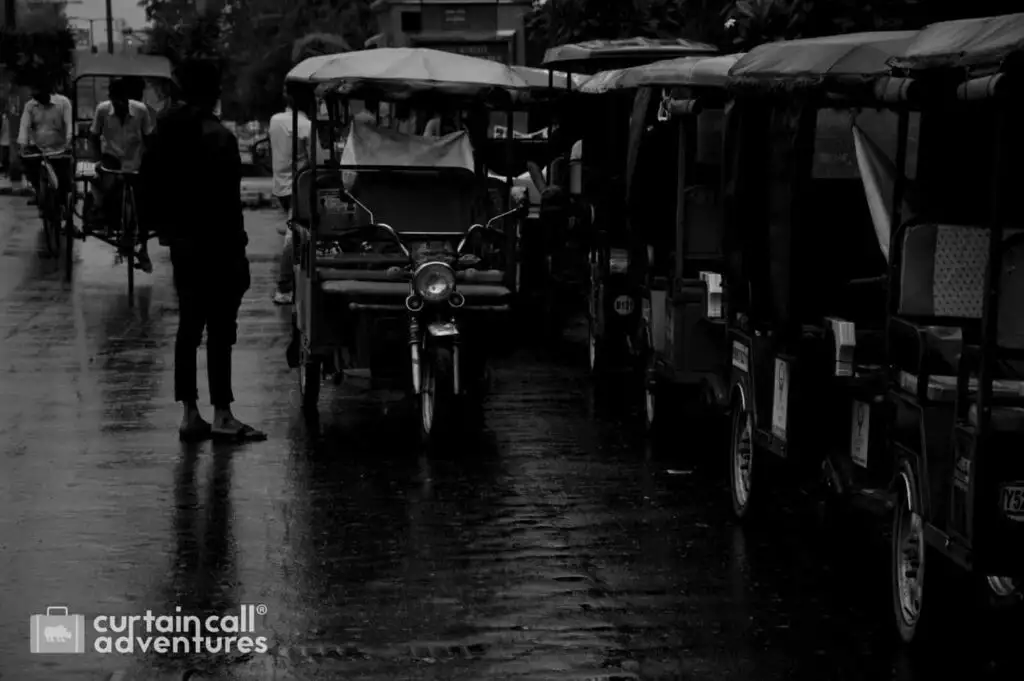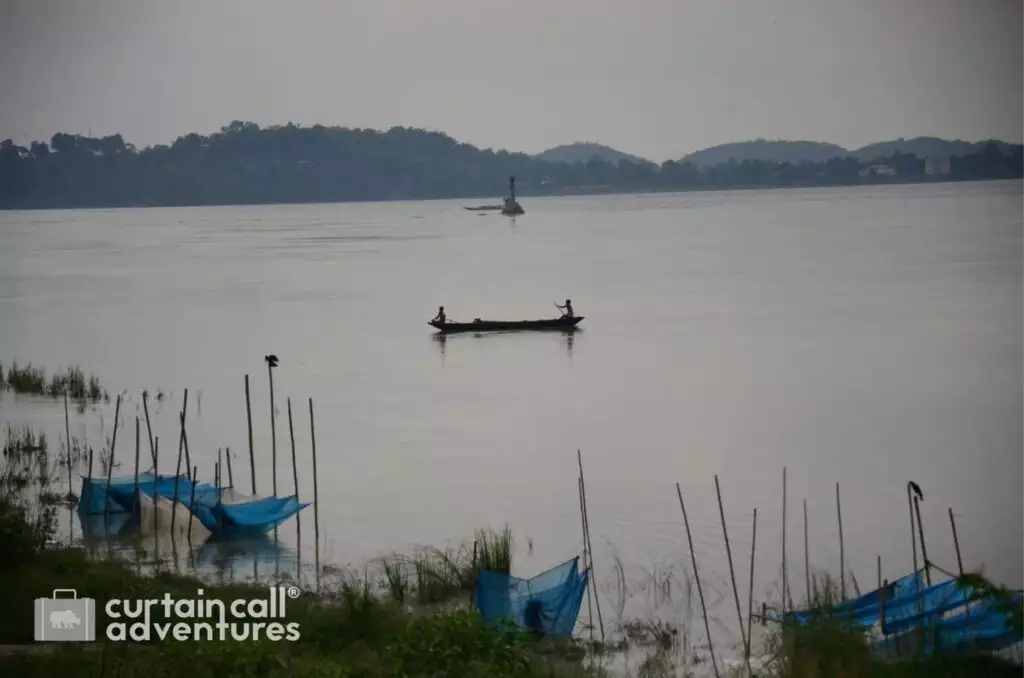 In my 10 years in Delhi, I have grown accustomed to a different flavour of the rains. As a thoroughly river-and-rain bred girl from small-town Assam, I grew up to the sound of heavy rains drumming the rooftop of the humble ‘Assam-type house’. Those angled rooftops were the only common sight of landscape I was a part of, though it has changed over the years with storey-ed buildings outranking the choice for this particular structure. The monsoons and architecture played the tunes of an uncommon jugalbandi in my growing up years. There was thrill in the rising crescendo of a good night’s thunderstorm, catapulted further by assured and longstanding power cuts, the recipe of adventure. The arrival of countless moths, sitting on the outline of the table where the candle stood – a universe that made the study table enchanting for some reason, complete with shadows and pauses from the hum of routine, reason enough to close textbooks and complete the half-finished novel.
In my 10 years in Delhi, I have grown accustomed to a different flavour of the rains. As a thoroughly river-and-rain bred girl from small-town Assam, I grew up to the sound of heavy rains drumming the rooftop of the humble ‘Assam-type house’. Those angled rooftops were the only common sight of landscape I was a part of, though it has changed over the years with storey-ed buildings outranking the choice for this particular structure. The monsoons and architecture played the tunes of an uncommon jugalbandi in my growing up years. There was thrill in the rising crescendo of a good night’s thunderstorm, catapulted further by assured and longstanding power cuts, the recipe of adventure. The arrival of countless moths, sitting on the outline of the table where the candle stood – a universe that made the study table enchanting for some reason, complete with shadows and pauses from the hum of routine, reason enough to close textbooks and complete the half-finished novel.
The rainy season back home till today becomes an occasion of people and nature coming together as if to the beat of a drummer or the strings of a puppeteer. Rains bring diverse insects and molluscs to the doorsteps and the insides of the house, enlarging our family and turning us hosts to attend to their presence. I had an uncle who devised his own way getting rid of the relentless rush of moths and other rain-prone insects in his house. He would place a large tub of water with a candle stand in the middle of a room. Soon enough, we would find the tub full of moths but unable to move or fly anymore. Did the moths have to be killed to be stopped? I found no answers to such questions and the grownups had other important matters to attend to, of course. The courtyards full of encroaching weeds and lichens making the grounds slippery. The fathers of the neighbourhood had an added task of stocking packets of bleaching powder. If you visit my town even today during the rains, you will definitely catch sight of at least one neighbourhood uncle taking stock of the lichen in his yard with bleaching powder.
There are innumerable ponds in my hometown. There used to be, at least. Ponds are excellent sources of fish. No Assamese meal is complete without fish. We can identify river-bred fish from the ones bred in ponds, just by their taste. Monsoons feed these ponds and what a great time for fish lovers that is! We cook and relish them in all ways possible – wrapped in plantain leaves and steamed; crispy fried in mustard oil; tangy curry with kokum, tomatoes or elephant apples; or dipped in spicy mustard sauce. So many of our evenings are spent on the veranda during rains, catching raindrops flowing down the rooftop in the palms of our hands while the smell of fried fish wafts from the kitchen, anticipating the evening cup of red tea even more. Such are the tales of raintime in Assam. They come in pleasant waves, like the Luit’s calm winter shores, or in sudden jolts of remembrance like the river in peril during floods.
 Monsoons are an ecosystem in itself, home to contradictions and (un)predicatability. They are a conglomeration of hope, of farmers’ prayers, of life and rejuvenation, of setting the landscape free from the dusty grip of Bordoisila. Yet, the monsoons also ravage the state with disastrous floods every year, like a ritual, made worse by deforestation, human encroachment and lack of drainage. Floods have been a part of Assam’s topography and indigenous people have devised ways of adapting to the natural hazard. The floods today are of a different nature, though, aggravated by the destruction of naturally rain-soaking areas like wetlands and the uncontrolled expansion of concrete spaces without a proper drainage system in place.
Monsoons are an ecosystem in itself, home to contradictions and (un)predicatability. They are a conglomeration of hope, of farmers’ prayers, of life and rejuvenation, of setting the landscape free from the dusty grip of Bordoisila. Yet, the monsoons also ravage the state with disastrous floods every year, like a ritual, made worse by deforestation, human encroachment and lack of drainage. Floods have been a part of Assam’s topography and indigenous people have devised ways of adapting to the natural hazard. The floods today are of a different nature, though, aggravated by the destruction of naturally rain-soaking areas like wetlands and the uncontrolled expansion of concrete spaces without a proper drainage system in place.
I grew up hearing about the disastrous floods of 1988, when the river changed course and flooded everything on its way. My earliest memory of floods is from 1998. Our school, located on the banks of the river, had sunk to half overnight. It sparked my imagination to build stories of an underwater world building right beneath the classrooms that we frequented every day. The pond in our backyard had swollen and swallowed the staircases to our home, with hyacinths strewn all over.
This year, the rains have been uncannily scarce in Delhi. The monsoons kept us waiting till July. Scanty showers that we lapped up thirstily while cursing the waterlogged streets. Here, too, deforestation and urban encroachment have wreaked havoc. The Aravalis that otherwise shielded the city from the western Indian desert have been systematically felled over the years.
I still long for the magic of the monsoons in Assam overloaded with greenery and growth.
Image courtesy: Anangsha Alomyan (Instagram handle: @thebrooklynomad)
Article courtesy: Prerana Choudhury (Instagram handle: @starr_e_nightt)
Reference: Shaswati Das and Mayank Aggarwal (2017) ‘Why Assam Faces Floods Every Year’, LiveMint (available at https://www.livemint.com/Politics/JEGERRSFHOVCAm86Pd1tnL/Why-Assam-faces-floods-every-year.html )


